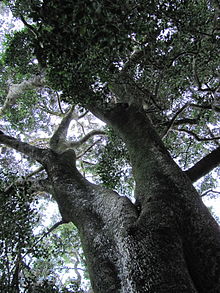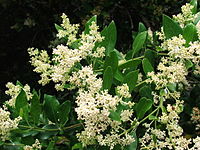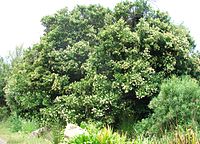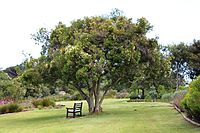- Olea capensis
-
Olea capensis 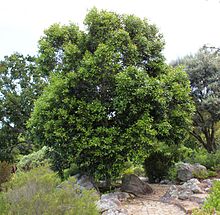
Scientific classification Kingdom: Plantae (unranked): Angiosperms (unranked): Eudicots (unranked): Asterids Order: Lamiales Family: Oleaceae Genus: Olea Species: O. capensis Binomial name Olea capensis Olea capensis, the Black Ironwood tree, is an African tree species belonging to the olive family (Oleaceae). Olea capensis is widespread in Africa. It is found almost throughout Africa south of the Sahara desert from the east in Somalia, Ethiopia and Sudan, south to the tip of South Africa, and west to Cameroon. Sierra Leone, and the Islands of the Gulf of Guinea. It occurrs in bush, littoral scrub and evergreen forest.
Olea capensis is known by a variety of common names including: [1]
- Afrikaans: ysterhout
- English: black ironwood, East African olive, Elgon olive, ironwood, ironwood olive
- Swahili: loliondo, mushargi
- Trade names: loliondo, mutharage, mutharagi, olive
Contents
Description
Olea capensis is a bushy shrub, or a small to medium sized tree, up to 10 metres (33 ft) in height, occasionally reaching 40 metres (130 ft).[1]
- Bark: light grey, becoming dark grey and vertically fissured with age; a characteristic blackish gum is exuded from bark wounds.
- Leaves: light to dark green and glossy above and paler green below; petiole often purplish, 0.3-1.7 cm long; lanceolate-oblong to almost circular, 3-10 x 1.5-5 cm.
- Flowers: white or cream and sweetly scented, small and in many flowered axillary or terminal heads, 3-15 cm long.
- Fruit: when ripe they are somewhat succulent purplish drupes; ovoid up to 2 x 1 cm.
Subspecies
The species has been divided into 3 subspecies:[1]
- Olea capensis ssp. macrocarpa: flowers in lax heads, fruits oblong to elliptic.
- Olea capensis ssp. capensis: flowers in dense heads, leaves very variable, apex often rounded, and fruits almost spherical to oblong elliptic.
- Olea capensis ssp. enervis: leaves usually broadly elliptic, apex tapering.
Uses
- Food
Olea capensis has masses of sweetly-scented bisexual flowers, that produce large edible fruits.
- Lumber
The wood of the tree is very hard, fine grained, and heavy, and although difficult to work, it is widely used for art and artifacts.
- Gardens
Olea capensis is cultivated as an ornamental tree in parks and gardens.
References
- ^ a b c Olea capensis @ world agroforestry centre.org; accessed 4.4.2011
- "Olea capensis". Ecocrop FAO. http://ecocrop.fao.org/ecocrop/srv/en/cropView?id=8059. Retrieved 2010-02-09.
- "Olea capensis subsp. capensis". Aluka. http://www.aluka.org/action/showCompilationPage?doi=10.5555/AL.AP.COMPILATION.PLANT-NAME-SPECIES.OLEA.CAPENSIS. Retrieved 2010-02-09.
- "Olea capensis subsp. capensis". Fernkloof Nature Reserve. http://fernkloof.com/species.mv?159. Retrieved 2010-02-09.
External links
Categories:- Olea
- Trees of Africa
- Trees of South Africa
- Flora of East Africa
- Flora of Southern Africa
- Flora of Angola
- Flora of Botswana
- Flora of Cameroon
- Flora of the Central African Republic
- Flora of the Republic of the Congo
- Flora of the Democratic Republic of the Congo
- Flora of Djibouti
- Flora of Equatorial Guinea
- Flora of Eritrea
- Flora of Ethiopia
- Flora of Gabon
- Flora of Kenya
- Flora of Lesotho
- Flora of Madagascar
- Flora of Malawi
- Flora of Mozambique
- Flora of Namibia
- Flora of Rwanda
- Flora of São Tomé and Príncipe
- Flora of Sierra Leone
- Flora of Somalia
- Flora of South Africa
- Flora of Sudan
- Flora of Swaziland
- Flora of Tanzania
- Flora of Zambia
- Flora of Zimbabwe
- Trees of Cape Town
- Fodder
- Wood
- Trees of Mediterranean climate
- Drought-tolerant trees
- Garden plants of Africa
- Ornamental trees
Wikimedia Foundation. 2010.

